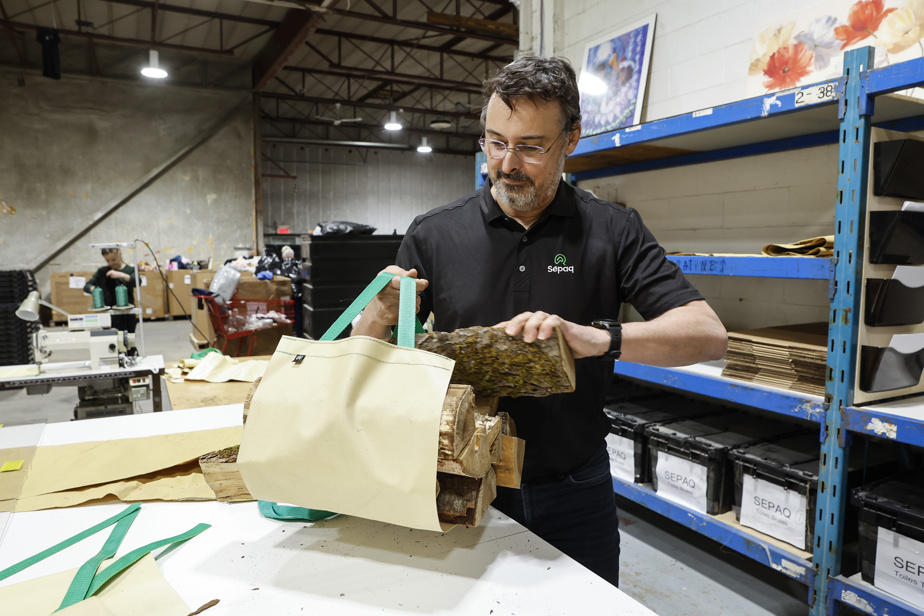(Sherbrooke) Campers staying at Camping des Voltigeurs in Drummondville will soon be carrying their logs in a bag with strangely familiar colors. And for good reason: they will be made with the beige canvas of the Huttopia tents at the end of the course, the result of a circular economy agreement between SEPAQ and the Estrie integration company Récupex.
Housed in the middle of an industrial zone in Sherbrooke, the Récupex warehouse is a real crossroads for textiles in search of a new life.
The non-profit organization, which manages a hundred donation bells in Estrie, is the largest clothing collector in the region. He receives about £4 million worth of clothes a year.
In sorting, the most beautiful pieces are kept for the stylish thrift store t.a.f.i. et cie, located on Wellington North, downtown. The rest is transferred to the Renaissance social economy organization – except for leather and fur coats. These are set aside to serve as raw material for bags, mittens, cases and other cushions made on the second floor, in the sewing workshop. These meticulous creations, made by participants in Services Québec’s Experience in Work Integration program, are also sold at t.a.f.i.
Reselling these leather and fur coats as is in the thrift store would undoubtedly bring in more money, recognizes the general manager, Danny Roy.
“But we are an integration company: our objective is to allow people to have work experience to integrate into the job market,” he explains.
The participants (mostly women) take six months of practical training, 35 hours a week paid by Services Québec. Several participants being immigrants or refugees, francization courses are also offered on site.
This mission, and the significant storage capacity of Récupex, convinced the sustainable development manager of the Société des Établissements de Plein Air du Québec (SEPAQ).
“Over the next five years, we will have around 500 Huttopia tents to renew”, emphasizes Hugues Sansregret. These tents used for ready-to-camp, a trend sometimes referred to as “glamping”, need to be replaced when they have holes or damage, approximately every five years. Bic National Park was the first to raise the issue: what to do not to throw away all this canvas?
“We did an internal consultation of the employees,” says Mr. Sansregret. Since SEPAQ has several barbecue models, the idea of a cover for these appliances had to be discarded. “But when the log rack came out at the maintenance managers meeting, everyone said yes!” »
These carrier bags open on the sides are made of a simple textile panel with straps. SEPAQ buys up to 2,000 a year from the lowest bidders retained by Quebec. But for this new project, it is rather a sewing service that she needed. Her research led her to Récupex.
After a few months of testing prototypes and manufacturing processes, the company installed a brand new workstation in the heart of its warehouse, with a cutting table for fabrics, a station for cords and two sewing machines.
Each log rack must be able to support the weight of 0.7 cubic feet of logs. The less sturdy matte canvas needs to be doubled, allowing for 60 log racks per tent, compared to 120 with the gloss finish tents. About 70% of the paintings are recovered in this way. And that’s not counting the metal fasteners and the canvas of the interior dividers of the tents, never exposed to the weather, which could be used to make other items, such as bags.
This log rack costs SEPAQ $7, which is about $2.50 more than the model currently purchased from suppliers with the lowest bids.
“It costs us more, but it’s candy in our eyes because we put the money back into the circular economy. We create job opportunities and the money stays with us. The benefit is much greater,” Mr. Sansregret argues.
And without this project, SEPAQ would have had to pay to get rid of its 500 tents. “That’s the equivalent of six hectares of canvas: there’s an environmental cost and a management cost to that!” So it was not very difficult to sell to us. »
The first 800 log carriers to come out of Récupex by the end of May will go to Camping des Voltigeurs. The next ones will be divided between Frontenac and Mont-Mégantic national parks during the summer. The others will then be distributed gradually throughout the rest of the SEPAQ network.

